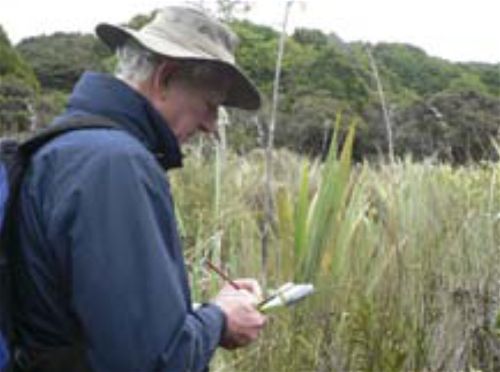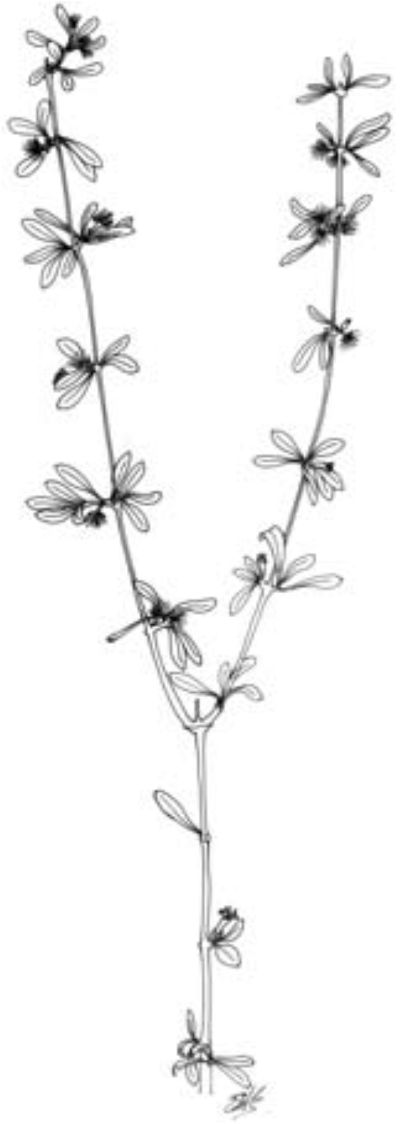Trip Report – 6 November 2010: Mohaka Street Wetland, Wainuiomata
 |
| Chris Hopkins, Mohaka St wetland. Photo: Mick Parsons. |
Despite contending with a cold southerly and showers, we began by botanising along the true right margin of the wetland under tall kanuka, with beech forest on the adjoining hillside. We saw: narrow-leaved mahoe /
Melicytus lanceolatus,
Pterostylis graminea agg.,
Simpliglottis cornuta,
Drosera peltata subsp.
auriculata,
Schoenus maschalinus and
Gahnia xanthocarpa. Later we noted strong regeneration of kahikatea, with large trees covered in leather-leaf fern, supplejack, clematis and lichens, then looked for small, epiphytic orchids on them, but without success. Behind the kahikatea, in the main tributary, we saw: small-leaved milk tree, swamp maire and
Hymenophyllum frankliniae at an unusually low altitude for this fern.
The wetland covers c. 200m x 200m, and contains no areas of open water.
Olearia virgata is a feature here, with stands obviously of great age. It was also pleasing to find the “In Decline” native buttercup,
Ranunculus macropus, here. Plants dominating the wetland cover include:
Baumea rubiginosa,
B. tenax,
Carex geminata,
C. secta, putaputaweta, swamp coprosma,
Coprosma robusta, swamp flax, and raupo.
 |
| Olearia virgata. Illustration: Eleanor Burton. |
The quality of the wetland has been compromised by the sale of land close to its margins on either side, and by drainage channels dug across the top of Mohaka Street. This aside, the whole catchment is worthy of protection in perpetuity by gazettal as a Scenic Reserve under the Reserves Act 1977.
There are several problem weed species in the catchment, including flowering cherry, karaka (many seedlings / saplings seen), gorse (in wetland), Himalaya honeysuckle, tree heath, and
Juncus effusus. Possum control is by bait stations placed along cut lines. We saw heavy deer browse on large-leaved coprosma species, pate, etc., so deer-culling is urgently required.
Participants : Julia Fraser, Ken Fraser, Chris Hopkins (leader / scribe), Chris Horne, Rodney Lewington, Barbara Mitcalfe, Mick Parsons, Darea Sherratt, Sunita Singh, Carol West.
Wainuiomata people
Wainuiomata is a suburb surrounded by some of the best native forest of the lower North Island. There doesn’t seem to be a patch of bush that Wainuiomata’s ecosystem-warrior, Chris Hopkins, hasn’t investigated thoroughly. He led us on what seemed like a short walk from the end of suburban Mohaka Street, and before we knew it, we had moved through a range of forest types with distinct associations of species probably influenced by the various disturbances, such as logging and grazing, that occurred fifty or more years ago. We then crossed an arm of the extensive swamp that absorbs the runoff from the surrounding forest and, onto a dry spur. Here we stopped for lunch under a forest featuring two hard beech cohorts interspersed with older black beech. By this time the deceptive landforms, and dense vegetation had me hoping that Chris could lead us out of here! The clear gumboot-deep water that lazed its way through the swamp seemed to be running in the wrong direction, and gullies seemed to be all round us. Only one led to Wainuiomata; but which one?
The species list of over 160 native vascular plants that Chris had compiled indicated he had been here several times, and his blue-ribboned trails that criss-crossed the forest and swamp confirmed this. They led the way to some of the highlights he didn’t want us to miss. Across the wet forest floor he took us to see young swamp maire,
Syzygium maire, and further on to a wheki covered in
Hymenophyllum flankliniae, the only recorded sighting in the catchment. It was then back into the swamp for an ‘absorbing’ trudge through an avenue of
Olearia virgata, some smothered in
Clematis foetida interspersed with 3m tall
Phorium tenax. Here, in knee-deep water, Chris showed us
Ranunculus macropus in flower, and finally led us into an open area (so that we could see where we were) where, in the only open pool, was
Eleocharis acuta. We were able to add only a few names to Chris’s list before going back across the swamp, under the manuka and kanuka canopy, where four kereru waited to farewell us. Chris is concerned about the scattered individuals of
Prunus serrulata and
Leycesteria formosa we saw from the swamp’s edge. Wainuiomata is lucky to have such a keen observer of its ecosystems. The managers of this reserve should take serious note of his concerns.
Mick Parsons

 Site Index
Site Index







 Site Index
Site Index





